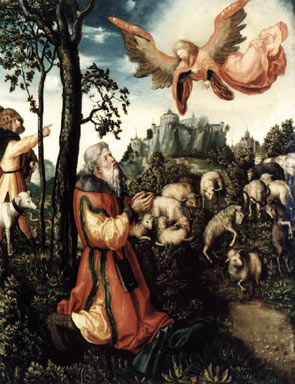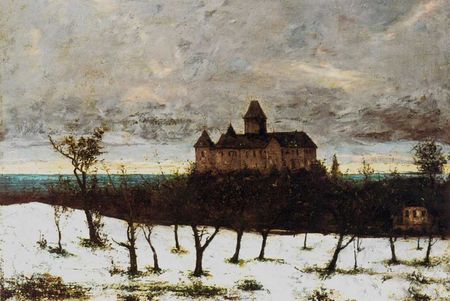Lawsuit BY Heirs to the Herzog Collection Over $100 Million Art Collection is Largest Holocaust Art Claim
Lucas Cranach the Elder, The Annunciation to Saint Joachim
WASHINGTON, DC.- Heirs to the Herzog Collection, the largest private art collection in Hungary prior to World War II, filed suit in the United States District Court for the District of Columbia late yesterday to seek the return of artworks illegally held by Hungary since the Holocaust. The heirs are also demanding a full and transparent inventory of looted art from the Herzog Collection held by Hungary, marking the first time a request of this nature has ever been made in an art restitution lawsuit.
The lawsuit seeks the return of over 40 artworks with a combined value of over $100 million, including masterworks by El Greco, Francisco de Zurbarán, and Lucas Cranach the Elder. The works come from the collection of Baron Mór Lipót Herzog, a passionate Jewish art collector, and the case is regarded by experts as the world’s largest unresolved Holocaust art claim. Hungary, a WWII-era ally of Nazi Germany that organized the dispossession, seizure, deportation, and eventual deaths of more than 500,000 Hungarian Jews, has held the artworks since the genocide of its Jewish population, despite years of negotiations and international appeals for the collection’s return from multiple U.S. Senators.
Major Works in Herzog Collection
Before his death in 1934, Baron Mór Lipót Herzog amassed approximately 2,500 paintings, sculptures, and other artworks in what was one of the finest collections of art in all of Europe. Among the artworks at issue in this case are:
· The Agony in the Garden, an oil-on-canvas masterwork that was one of six El Greco paintings in the former Herzog Collection;
· The Portrait of Don Balthasar Carlos, by Alonso Cano, the Spanish painter and sculptor known as “the Michelangelo of Spain”;
· The Spring, by Gustave Courbet, the innovative French painter who lead the Realist movement in 19th-Century France; and
· Portrait of a Woman (Lady with a Marguerite (Daisy)), by Camille Corot, the 19th-Century French landscape painter of whom the impressionist master Claude Monet said, “We are nothing compared to him, nothing.”
Case Summary
The complaint filed yesterday sets out the remarkable and disturbing facts of the case, including:
· At its peak, the Herzog Collection included approximately 2,500 works of art, including paintings by El Greco, Velázquez, Renoir, Corot, and Monet.
· After the widow of Baron Mór Lipót Herzog died in 1940, the collection was passed to her three children: Erzsébet, István, and András.
· Hungary sent András to a forced labor camp in 1942; he died on the Russian front in 1943. His daughters, who fled Hungary after their father’s deportation and death, are plaintiffs in this suit.
· Hungary attempted to send István to the infamous Auschwitz camp, though he escaped to a safe house. The heirs of István and Erzsébet have assigned their interest in the Herzog Collection to David de Csepel, the lead plaintiff.
· The Hungarian government worked hand-in-hand with the infamous Nazi SS commander Adolf Eichmann in organizing large-scale deportations of Hungarian Jews to German death camps. Between mid-May and July 1944, Hungarian authorities deported over 430,000 Jews, comprising more than 50% of the Hungarian Jewish population.
· In May 1944, the Hungarian Ministry of the Interior issued a decree requiring Jews to register all art objects in their possession.
· The Herzog family attempted to save their artworks from damage and confiscation by hiding the bulk of it in the cellar of one of the family’s factories at Budafok. Dénes Csánky, director of the Museum of Fine Arts, assisted in packing and hiding the artworks. Despite their efforts to prevent the looting of the art, the Hungarian government and their Nazi collaborators discovered the hiding place (Csánky inventoried the treasures as they emerged). The seized artworks were taken to Adolf Eichmann, who selected many of the best pieces of the collection, first displaying his “trophies” and then shipping them to Germany. The remainder was handed over by the Hungarian government to the Museum of Fine Arts for safekeeping.
· Under the 1947 Treaty of Peace between Hungary and the Allies, ownership rights to the Herzog Collection remained with the Herzog heirs.
· The artworks that are the subject of this lawsuit are among the main attractions at Hungary’s Museum of Fine Arts and the Hungarian National Galley. One guidebook to the Museum of Fine Arts includes four art works from the collection, including El Greco’s The Agony in the Garden, while another guidebook includes two artworks from the collection.
· The museums display works from the Herzog Collection prominently and have included tags identifying them as being “from the Herzog Collection.”
· The museums have promoted and distributed books, including Treasures of Venice: Paintings from the Museum of Fine Arts, Budapest, that include works from the Herzog Collection.
· The Budapest University of Technology and Economics and the Museum of Applied Arts in Budapest also possess artworks from the Herzog Collection.
· At the 1998 Washington Conference on Holocaust-Era Assets, an international conference on the persistent issues surrounding Nazi-looted art, the Hungarian government pledged that it was “fully committed to the restitution or compensation of Holocaust victims concerning cultural assets. For managing this complex task . . . a state commissioner will be designated.” Twelve years later, no commissioner has been appointed.
Gustave Courbet, Le Château de Blonay (neige), (The Chateau of Blonay (snow).

/https%3A%2F%2Fprofilepics.canalblog.com%2Fprofilepics%2F1%2F0%2F100183.jpg)
/https%3A%2F%2Fstorage.canalblog.com%2F03%2F02%2F119589%2F96711876_o.jpg)
/https%3A%2F%2Fstorage.canalblog.com%2F11%2F31%2F119589%2F94773502_o.jpg)
/https%3A%2F%2Fstorage.canalblog.com%2F20%2F83%2F119589%2F94772815_o.jpg)
/https%3A%2F%2Fstorage.canalblog.com%2F26%2F72%2F119589%2F75604929_o.jpg)
/https%3A%2F%2Fstorage.canalblog.com%2F59%2F60%2F119589%2F26458628_o.jpg)




/http%3A%2F%2Fstorage.canalblog.com%2F30%2F56%2F119589%2F126996791_o.jpg)
/http%3A%2F%2Fstorage.canalblog.com%2F03%2F74%2F119589%2F126106621_o.png)
/http%3A%2F%2Fstorage.canalblog.com%2F22%2F39%2F119589%2F118067112_o.jpg)
/http%3A%2F%2Fstorage.canalblog.com%2F13%2F35%2F119589%2F112598146_o.jpg)